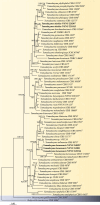Yamadazymaakebiae sp. nov. and Y.hainanensis sp. nov. (Debaryomycetaceae, Saccharomycetales) from leaf in China
- PMID: 40697983
- PMCID: PMC12280967
- DOI: 10.3897/mycokeys.119.156745
Yamadazymaakebiae sp. nov. and Y.hainanensis sp. nov. (Debaryomycetaceae, Saccharomycetales) from leaf in China
Abstract
Members of the genus Yamadazyma are widely distributed and frequently found in plant materials. In an effort to investigate the species diversity within this genus, leaf samples collected from Guizhou and Hainan provinces in China were examined. This study led to the discovery of two previously undescribed taxa. Phenotypic examination, combined with phylogenetic analysis based on concatenated ITS and LSU D1/D2 sequences, confirmed their affiliation with Yamadazyma and supported their designation as novel species. One of the new species, Yamadazymaakebiae sp. nov., is phylogenetically closely related to Y.kanchanaburiensis, whereas Y.hainanensis sp. nov. represents a distinct lineage, clearly separated from other known Yamadazyma species. Detailed descriptions, illustrations, and comparative discussions with their nearest relatives are provided. These findings contribute two additional species to the genus and enhance our understanding of Yamadazyma diversity in China.
Keywords: Ascomycetous yeast; phylloplane; phylogeny; taxonomy.
Peng Wang, Chun-Yue Chai, Qiu-Hong Niu, Feng-Li Hui.
Conflict of interest statement
The authors have declared that no competing interests exist.
Figures



Similar articles
-
Yamadazyma oleae f.a. sp. nov. and Yamadazyma molendinolei f.a. sp. nov., two novel ascomycetous yeast species isolated from olive oil mills in Italy, and reassignment of 11 Candida species to the genus Yamadazyma.Int J Syst Evol Microbiol. 2024 Dec;74(12). doi: 10.1099/ijsem.0.006592. Int J Syst Evol Microbiol. 2024. PMID: 39621539
-
Unveiling Species Diversity Within Early-Diverging Fungi from China VI: Four Absidia sp. nov. (Mucorales) in Guizhou and Hainan.Microorganisms. 2025 Jun 5;13(6):1315. doi: 10.3390/microorganisms13061315. Microorganisms. 2025. PMID: 40572203 Free PMC article.
-
Diaporthe species on palms - integrative taxonomic approach for species boundaries delimitation in the genus Diaporthe, with the description of D. pygmaeae sp. nov.Stud Mycol. 2024 Dec;109:487-594. doi: 10.3114/sim.2024.109.08. Epub 2024 Oct 23. Stud Mycol. 2024. PMID: 39717652 Free PMC article.
-
Health professionals' experience of teamwork education in acute hospital settings: a systematic review of qualitative literature.JBI Database System Rev Implement Rep. 2016 Apr;14(4):96-137. doi: 10.11124/JBISRIR-2016-1843. JBI Database System Rev Implement Rep. 2016. PMID: 27532314
-
Factors that influence parents' and informal caregivers' views and practices regarding routine childhood vaccination: a qualitative evidence synthesis.Cochrane Database Syst Rev. 2021 Oct 27;10(10):CD013265. doi: 10.1002/14651858.CD013265.pub2. Cochrane Database Syst Rev. 2021. PMID: 34706066 Free PMC article.
References
-
- Al-Sweih N, Ahmad S, Khan S, Khan Z, Joseph L, Vayalil S, Chandy R. (2017) Persistent Candidaconglobata bloodstream infection in a preterm neonate successfully treated by combination therapy with amphotericin B and caspofungin. Journal de Mycologie Médicale 27(2): 71–276. 10.1016/j.mycmed.2017.01.010 - DOI - PubMed
-
- Am-In S, Limtong S, Yongmanitchai W, Jindamorakot S. (2011) Candidaandamanensis sp. nov., Candidalaemsonensis sp. nov. and Candidaranongensis sp. nov., anamorphic yeast species isolated from estuarine waters in a Thai mangrove forest. International Journal of Systematic and Evolutionary Microbiology 61(2): 454–461. 10.1099/ijs.0.022038-0 - DOI - PubMed
-
- Andrew R. (2016) FigTree: Tree figure drawing tool Version 1.4.3. Institute of Evolutionary Biology, University of Edinburgh Press, United Kingdom.
-
- Avesani M, Zapparoli G, Jindamorakot S, Limtong S. (2024) Yamadazymaoleae f.a. sp. nov. and Yamadazymamolendinolei f.a. sp. nov., two novel ascomycetous yeast species isolated from olive oil mills in Italy, and reassignment of 11 Candida species to the genus Yamadazyma. International Journal of Systematic and Evolutionary Microbiology 74(12): ее006592. 10.1099/ijsem.0.006592 - DOI - PubMed
-
- Billon-Grand GA. (1989) A new ascosporogenous yeast genus: Yamadazyma gen. nov. Mycotaxon 35: 201–204.
LinkOut - more resources
Full Text Sources
